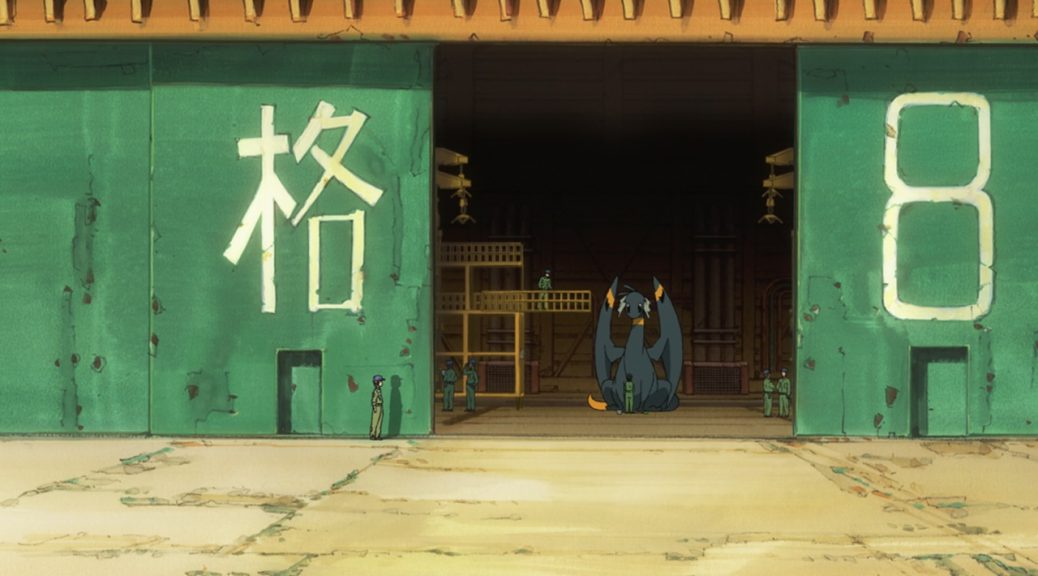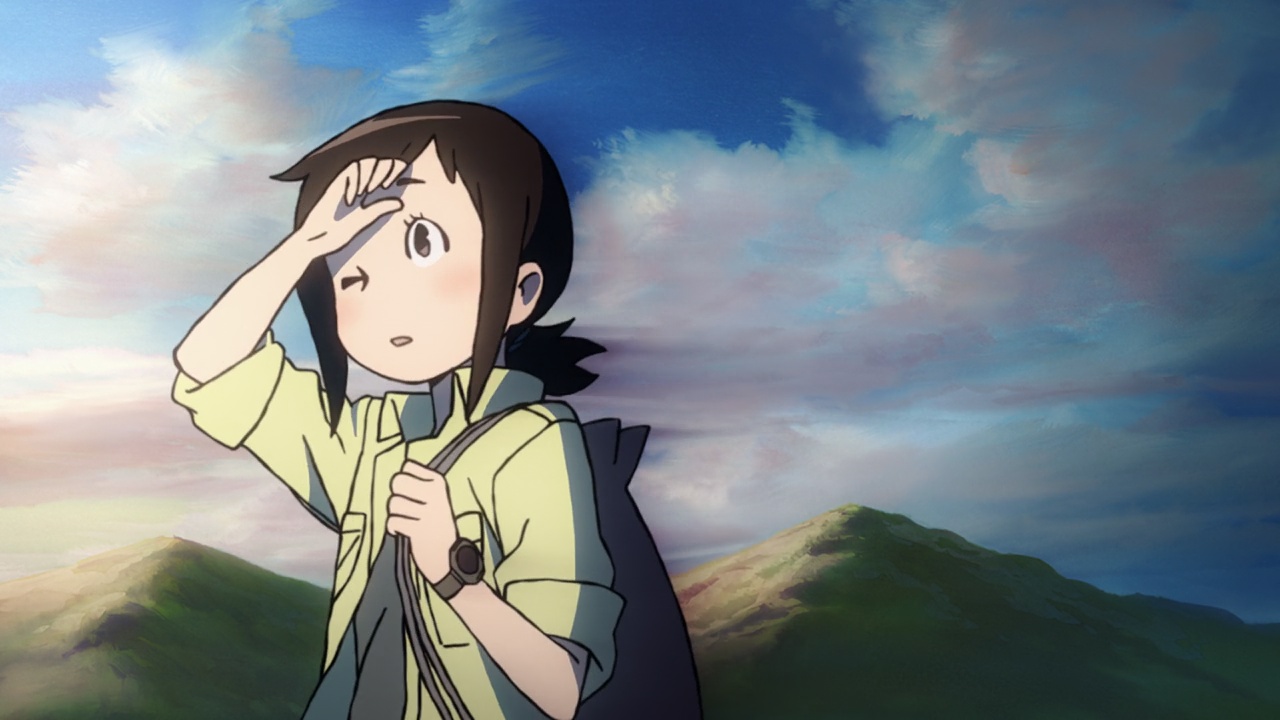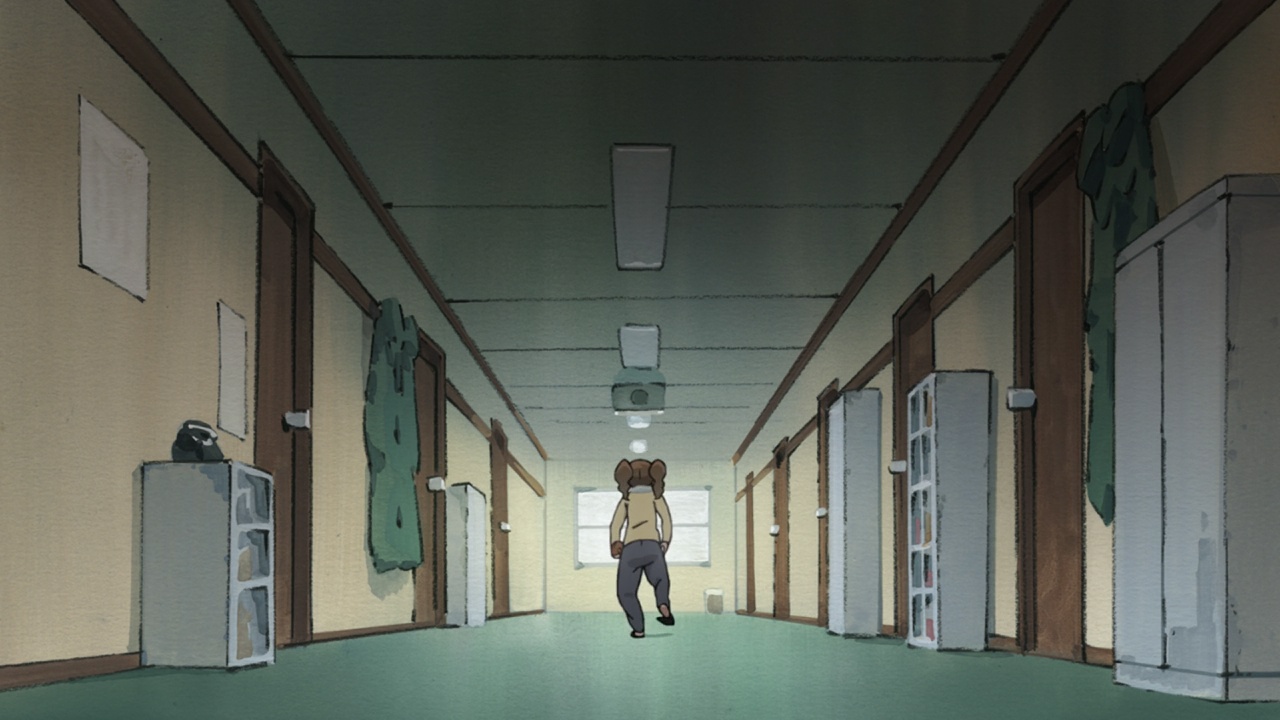
Dragon Pilot: Hisone & Masotan Production Notes 02
HisoMaso is back with a much more grounded character episode… as much as you can ground a jet dragon to the floor, anyway. The series is living up to the expectations, not only when it comes to the content of the series but also the wonderful ending that all pre-screening attendees had already been charmed by. Let’s look at the team who’s making this delightfully unique series possible!
Episode 2
StoryboardStoryboard (絵コンテ, ekonte): The blueprints of animation. A series of usually simple drawings serving as anime's visual script, drawn on special sheets with fields for the animation cut number, notes for the staff and the matching lines of dialogue.: Katsumi Terahigashi
Episode DirectionEpisode Direction (演出, enshutsu): A creative but also coordinative task, as it entails supervising the many departments and artists involved in the production of an episode – approving animation layouts alongside the Animation Director, overseeing the work of the photography team, the art department, CG staff... The role also exists in movies, refering to the individuals similarly in charge of segments of the film.: Geisei Morita
Chief Animation DirectionAnimation Direction (作画監督, sakuga kantoku): The artists supervising the quality and consistency of the animation itself. They might correct cuts that deviate from the designs too much if they see it fit, but their job is mostly to ensure the motion is up to par while not looking too rough. Plenty of specialized Animation Direction roles exist – mecha, effects, creatures, all focused in one particular recurring element.: Yoshiyuki Ito
Animation DirectionAnimation Direction (作画監督, sakuga kantoku): The artists supervising the quality and consistency of the animation itself. They might correct cuts that deviate from the designs too much if they see it fit, but their job is mostly to ensure the motion is up to par while not looking too rough. Plenty of specialized Animation Direction roles exist – mecha, effects, creatures, all focused in one particular recurring element.: Hiroko Kasuga, Chiyo Nakayama
Mecha Animation DirectionAnimation Direction (作画監督, sakuga kantoku): The artists supervising the quality and consistency of the animation itself. They might correct cuts that deviate from the designs too much if they see it fit, but their job is mostly to ensure the motion is up to par while not looking too rough. Plenty of specialized Animation Direction roles exist – mecha, effects, creatures, all focused in one particular recurring element.: Kazuki Kuramoto
Key AnimationKey Animation (原画, genga): These artists draw the pivotal moments within the animation, basically defining the motion without actually completing the cut. The anime industry is known for allowing these individual artists lots of room to express their own style.: Miki Sakaibara, Akihito Kato, Yuka Koiso, Saori Surugi, Fujiko Aoyagi, Akie Morimoto, Reika Hoshino, Yusuke Adachi, Ikko Inaguma, Tomoko Kusugi, Eddie Mehong, Remi Clark, Ken Arto, Yoko Kikuchi, Misao Abe, Kazuyo Nakamura, Naoko Ikeuchi, Kei Hyodo, Yoshifumi Nakamura, Hiroko Kasuga, Kazuki Kuramoto, Fuminori Tsukita, Tetsuya Matsukawa, Emiko Momose
─ Episode 2’s storyboardStoryboard (絵コンテ, ekonte): The blueprints of animation. A series of usually simple drawings serving as anime's visual script, drawn on special sheets with fields for the animation cut number, notes for the staff and the matching lines of dialogue. artist Katsumi Terahigashi is perhaps the most regular collaborator of BONES Sub-studio A. Formerly an animator, Terahigashi gradually switched to directorial duties and has since then been working as freelance storyboardStoryboard (絵コンテ, ekonte): The blueprints of animation. A series of usually simple drawings serving as anime's visual script, drawn on special sheets with fields for the animation cut number, notes for the staff and the matching lines of dialogue. artist for last two decades, occasionally slipping into scriptwriting as well. His history with BONES is a particularly fruity one as he’s been involved in projects spanning many genres, proving just how much faith the studio has in him. Busy as he always is, this wasn’t the first time he’d worked with series directorSeries Director: (監督, kantoku): The person in charge of the entire production, both as a creative decision-maker and final supervisor. They outrank the rest of the staff and ultimately have the last word. Series with different levels of directors do exist however – Chief Director, Assistant Director, Series Episode Director, all sorts of non-standard roles. The hierarchy in those instances is a case by case scenario. Hiroshi Kobayashi, since he had already assisted him on Kobayashi’s debut series Kiznaiver – considering the strong results, maybe we’re witnessing the beginning of a lasting relationship? As with most freelance storyboardStoryboard (絵コンテ, ekonte): The blueprints of animation. A series of usually simple drawings serving as anime's visual script, drawn on special sheets with fields for the animation cut number, notes for the staff and the matching lines of dialogue. artists, Terahigashi doesn’t possess a strong individual style when it comes to shot composition, which makes sense considering their job is to constantly readjust to each anime they’re working on. But while the storyboarding in this episode wasn’t as refined as in the premiere, there still were dozens of memorable shots throughout. Whether they came from Terahigashi’s own pen or Kobayashi’s corrections is up in the air, but I would say that they do have a different flavor from what Kobayashi has gotten us used to. Overall, this episode did a great job marrying the grand majesty inherent to the series with the more personal story we followed this time around.
─ As somebody who’s been following BONES’ works and related staff for almost a decade I have to admit the duo of animation directors which supervised this episode were an unknown factor for me. After a bit of research I found Hiroko Kasuga and Chiyo Nakayama have their roots at Production I.G, where they trained as in-between animators between 2009 and 2011. Both of them later went freelance but kept on working for I.G when requested, such as their latest major work Magical Circle Guru-Guru (2017). Taking into consideration the show’s cartoony art style I can see why HisoMaso’s production team chose to recruit animation directors with prior experience drawing stylized designs with often loose facial expressions. Coupled with the fact that a huge number of supervisors focused on episode 1 I can see them as a strong addition to the team. The mechanical animation directionAnimation Direction (作画監督, sakuga kantoku): The artists supervising the quality and consistency of the animation itself. They might correct cuts that deviate from the designs too much if they see it fit, but their job is mostly to ensure the motion is up to par while not looking too rough. Plenty of specialized Animation Direction roles exist – mecha, effects, creatures, all focused in one particular recurring element. this time around was Kazuki Kuramoto, a relatively inexperienced Sunrise-raised artist who only debuted as a key animator slightly over a year ago. Talk about rapid career progression after spending 7 years in training!
─ This lovely flight scene at the beginning of the episode serves as a good showcase of Kuramoto’s mechanical supervision abilities. Though the movement itself is nothing to speak of, what impressed me was the absurd, almost CG-like level of detail on Masotan everytime it flies away further from the screen. I also find all the scenes where Masotan transforms into the jet form and vice versa well worth bringing attention to; they’re not the most outstanding piece of animation by any means, but they’re something only an animator familiar with mecha quirks can handle, since there’s a very specific kind of coolness they’re meant to evoke. The episode’s other animation highlight were much more character focused, in line with the general tone of it, like Nao’s emotional outburst in the midst of it. I’m not quite sure who drew the key animationKey Animation (原画, genga): These artists draw the pivotal moments within the animation, basically defining the motion without actually completing the cut. The anime industry is known for allowing these individual artists lots of room to express their own style. for the sequence since there aren’t obvious candidates in the credits and it doesn’t seem to have obvious personal tells beyond the attractive timing, but either way it’s clear that the artist in charge can switch between semi-realistic and exaggerated character acting in an almost seamless manner. I absolutely adore Hisone’s overblown reaction to what she had done, which is one of the most amusing representations of her personal flaws. As a final note, I’d like to add that the episode featured key animationKey Animation (原画, genga): These artists draw the pivotal moments within the animation, basically defining the motion without actually completing the cut. The anime industry is known for allowing these individual artists lots of room to express their own style. of three french animators: Yapiko Animation‘s CEO Eddie Mehong, Remi Clark and Ken Arto. This show really congregates talent from all over the place.
─ And here’s our weekly Yuji Kaneko kicks ass corner, where we take a look at some of his stunning backgrounds.
Opening
StoryboardStoryboard (絵コンテ, ekonte): The blueprints of animation. A series of usually simple drawings serving as anime's visual script, drawn on special sheets with fields for the animation cut number, notes for the staff and the matching lines of dialogue. | Direction: Kotaro Tamura
Animation DirectionAnimation Direction (作画監督, sakuga kantoku): The artists supervising the quality and consistency of the animation itself. They might correct cuts that deviate from the designs too much if they see it fit, but their job is mostly to ensure the motion is up to par while not looking too rough. Plenty of specialized Animation Direction roles exist – mecha, effects, creatures, all focused in one particular recurring element.: Yoshiyuki Ito
Key AnimationKey Animation (原画, genga): These artists draw the pivotal moments within the animation, basically defining the motion without actually completing the cut. The anime industry is known for allowing these individual artists lots of room to express their own style.: Washio, Naoyuki Konno, Moe Usami, Yuuto Kaneko, Keigo Arihara, Yushi Tanaka, Naoto Abe, Ikko Inaguma, Keiichiro Honjo, Kazuki Kuramoto, Akira Yamashita, Kenji Mizuhata
─ Kotaro Tamura, best known as the director of Noragami, has become studio BONES’ most frequent opening and ending director; Gosick, Bungo Stray Dogs, Heroman, Blast of Tempest, Eureka Seven AO, there’s simply no end to the sequences he’s handled with them. Since his output is particularly biased towards Sub-studio A, his appearance over here wasn’t surprising in any way, although it’s quite rare to have one person who isn’t directing the series and yet gets trusted with both the opening and closing sequences.
─ The opening appears as rather subdued by his standards, but it appropriately matches the tone of the beautiful, soothing song accompanied by an orchestra. The idea is to showcase a standard launching and flight routine of the show’s core duo, which in its simplicity and visual sensibilities evoked somewhat nostalgic feelings in me. I believe that’s what Tamura aimed for with this sequence, as it – unlike other latenight anime counterparts – features on-screen lyrics, and the very simple typography reminiscent of cel-era anime doesn’t seem like a coincidence either. Combined with Yuji Kaneko’s always stunning traditionally-painted backgrounds, it’s a classic anime somehow made in 2018.
─ Despite featuring a very limited amount of movement the list of key animators is very stacked with talent. Some of the impressive appearances include versatile mecha and effects specialist Naoyuki Konno, Trigger-affiliated action animator Yuuto Kaneko, young animator on the brink of becoming a big name Moe Usami, and Shin-chan/Doraemon resident Akira Yamashita. Unfortunately the opening couldn’t take full advantage of their skills, so here’s hoping we’ll see them later in the show! On the contrary, the series’ main mecha/dragon animation director Keiichiro Honjo confirmed that he animated this short mid-air transformation cut which is very much within his strike zone.

Ending
StoryboardStoryboard (絵コンテ, ekonte): The blueprints of animation. A series of usually simple drawings serving as anime's visual script, drawn on special sheets with fields for the animation cut number, notes for the staff and the matching lines of dialogue. | Direction: Kotaro Tamura
Animation DirectionAnimation Direction (作画監督, sakuga kantoku): The artists supervising the quality and consistency of the animation itself. They might correct cuts that deviate from the designs too much if they see it fit, but their job is mostly to ensure the motion is up to par while not looking too rough. Plenty of specialized Animation Direction roles exist – mecha, effects, creatures, all focused in one particular recurring element.: Yoshiyuki Ito
Key AnimationKey Animation (原画, genga): These artists draw the pivotal moments within the animation, basically defining the motion without actually completing the cut. The anime industry is known for allowing these individual artists lots of room to express their own style.: Satoshi Ishino, Ryoko Amisaki, Nayumi Okashiwa, Arisa Hoshina
Yuki Igarashi
─ While Tamura’s opening felt rather reserved, the ending allowed him to unleash his true self. The pastel colors, texture overlays, film effects and such are quirks he’s shown his previous works and he definitely put them to good usage here, but ultimately the success of the sequence is more conceptual – dragon pilots awkwardly dancing to a cover of France Gall’s 1966 song might be the greatest thing to happen to anime in 2018 so far. So props to Tamura for the wonderful execution, but also to series directorSeries Director: (監督, kantoku): The person in charge of the entire production, both as a creative decision-maker and final supervisor. They outrank the rest of the staff and ultimately have the last word. Series with different levels of directors do exist however – Chief Director, Assistant Director, Series Episode Director, all sorts of non-standard roles. The hierarchy in those instances is a case by case scenario. Kobayashi for the unique approach and to the producers for enabling this madness. Quite the addictive, one of a kind ending they’ve put together!
─ Huge credit here also goes to BONES’ compositing crew, who Tamura likes to reward with Bikkuriman Chocolates. It seems they’re being devoured increasingly fast, so maybe this ending isn’t the only addictive thing.
─ The dancing was animated by the separately credited Yuki Igarashi, whose first big TV animation effort we covered with Mob Psycho 100. His spectacular action scenes were followed up by something less bombastic but equally impressive, as he moved to work on Production I.G’s adaptation of Welcome to the Ballroom. His role was quite tricky, since he had to comply to the production’s economic approach to the dancing sequences, but the aptitude he showed as a result was something beyond his age. Despite the limited frame count, Igarashi’s sequences left a tremendous impression. And one year later, that experience came in handy for this ending that also meant to feel memorable through short dancing loops. It’s always fascinating to see animators deliver great content not only in spite of limitations, but because of them.
BONES saiko
Support us on Patreon to help us reach our new goal to sustain the animation archive at Sakugabooru, SakugaSakuga (作画): Technically drawing pictures but more specifically animation. Western fans have long since appropriated the word to refer to instances of particularly good animation, in the same way that a subset of Japanese fans do. Pretty integral to our sites' brand. Video on Youtube, as well as this SakugaSakuga (作画): Technically drawing pictures but more specifically animation. Western fans have long since appropriated the word to refer to instances of particularly good animation, in the same way that a subset of Japanese fans do. Pretty integral to our sites' brand. Blog. Thanks to everyone who’s helped out so far!
